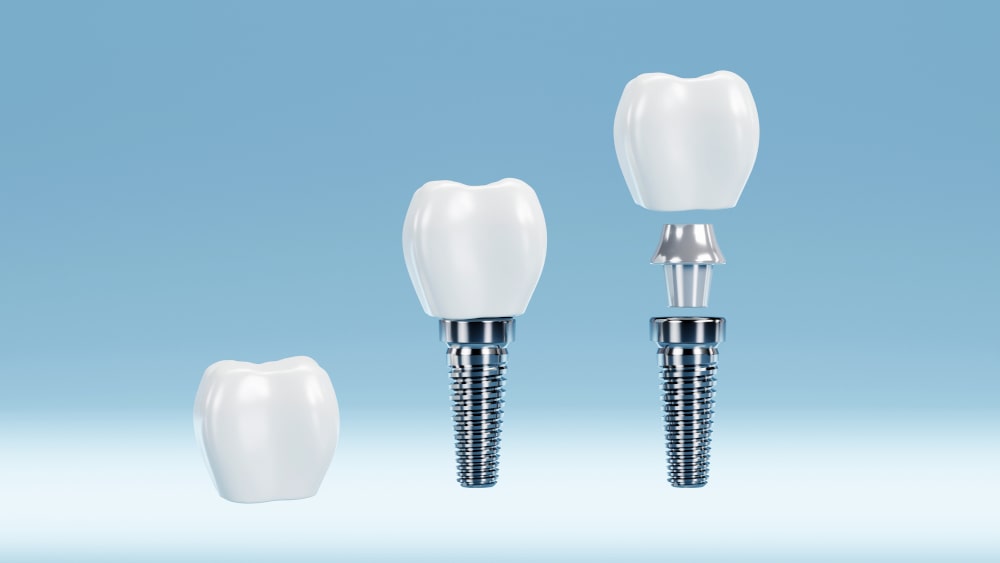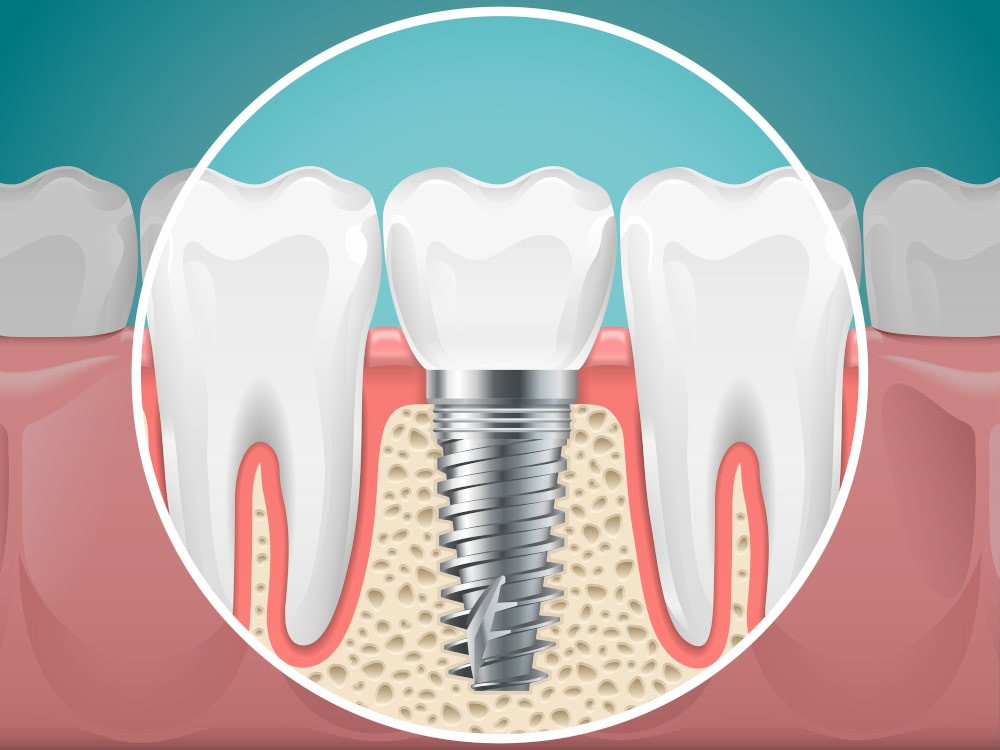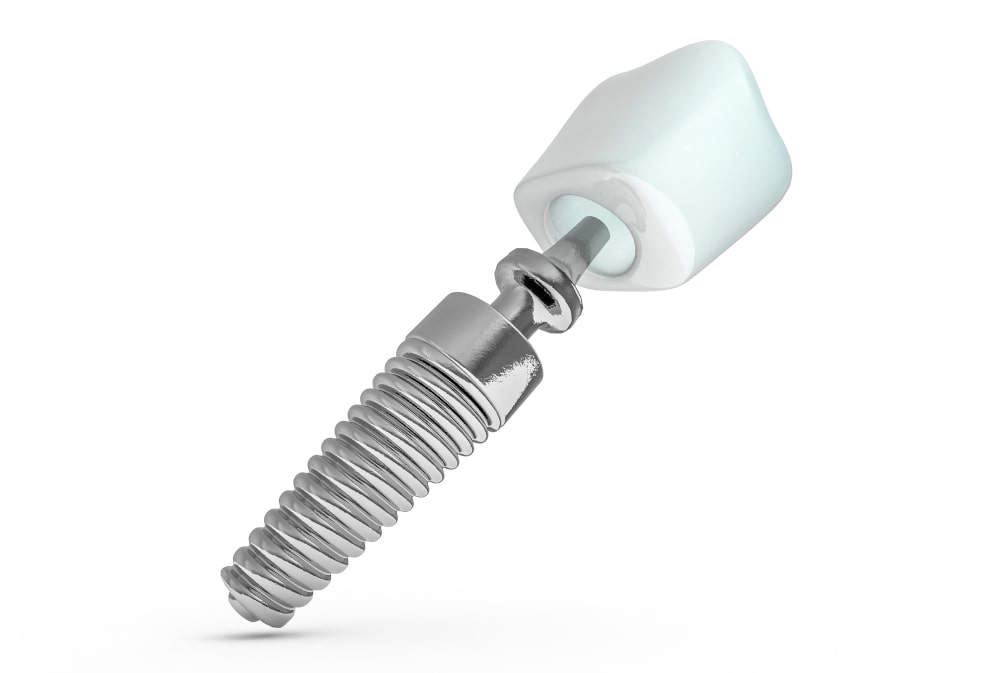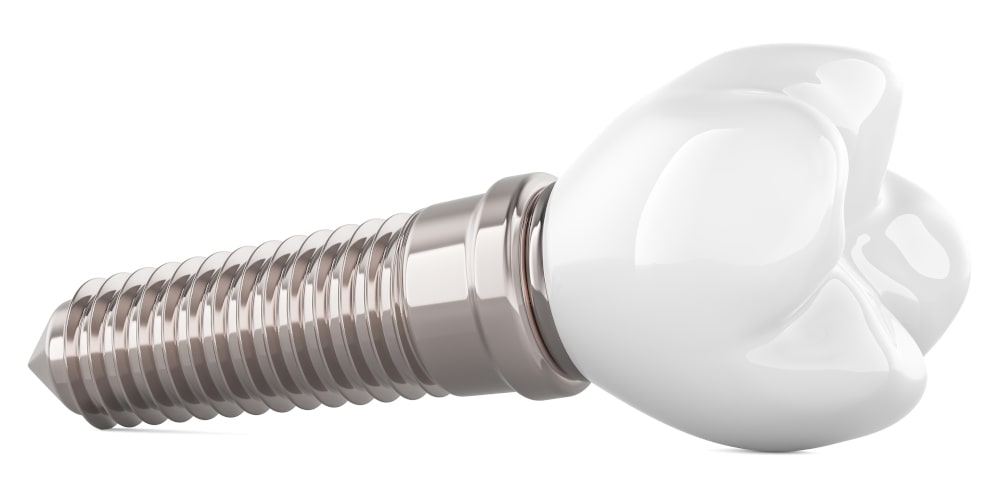
Key Takeaways
- Titanium and zirconia are the two leading materials used in dental implants, each with distinct strengths, risks, and applications that make them suitable for different clinical situations.
- Titanium implants offer proven durability, high strength, and flexibility, making them ideal for posterior (chewing) areas; however, their metallic colour can sometimes affect aesthetics, especially in the front teeth.
- Zirconia implants offer superior aesthetics due to their tooth-coloured, ceramic structure and are the preferred choice for visible zones, such as the front teeth. They are also hypoallergenic and metal-free, making them suitable for patients with metal sensitivities.
- Cost differences are significant: Zirconia implants are generally more expensive than titanium options because of material processing, customization, and laboratory requirements.
- Durability varies: Titanium implants have a long-established survival rate of 95–98% over 10–20 years, while zirconia implants show promising but less conclusive long-term data.
- Risk factors differ: Titanium carries a minimal but possible risk of allergic reaction and inflammation (peri-implantitis), whereas zirconia is more prone to fracture under stress but offers a reduced risk of plaque accumulation and inflammation.
- The choice between zirconia and titanium depends on patient-specific factors, including gum type, implant location, health conditions, aesthetic expectations, budget, and lifestyle habits, such as teeth grinding.
What are Dental Implants Made of and Why Does the Material Matter?
When considering dental implants, the first question often asked is critical yet straightforward: What are they made of, and why does it matter? Dental implants serve as the foundation for replacement teeth and must remain stable and functional for decades. This longevity and performance largely depend on the material composition.
Types of Dental Implant Materials
Titanium Implants
Titanium remains the most commonly used material for dental implants worldwide. Introduced in the 1960s, titanium is praised for its:
- Biocompatibility: The body readily accepts titanium without inflammation or rejection.
- Strength and Durability: It can endure chewing forces for 20 years or longer.
- Osseointegration: Titanium bonds seamlessly with bone tissue, forming a secure anchor.
However, a potential downside is aesthetic: titanium’s greyish colour can sometimes show through thin gums, which is less desirable in front-tooth implants.
Zirconia Implants
Zirconia is a ceramic material and a relative newcomer compared to titanium. Its key features include:
- Metal-Free Composition: Ideal for patients with metal sensitivities or allergies.
- Tooth-Coloured Aesthetics: Perfect for implants in the visible “smile zone.”
- Good Biocompatibility: Less plaque accumulation, reducing gum disease risk.
However, zirconia has limitations, such as brittleness, which makes it more prone to cracking under stress, and historically, there have been fewer long-term data points compared to titanium.

Why Material Matters
The material of an implant impacts several vital factors:
- Performance: Titanium excels in load-bearing applications; zirconia is better suited for aesthetic purposes.
- Longevity: Titanium implants can last 20 years or more; zirconia’s lifespan is promising but less proven.
- Aesthetics: Zirconia offers superior gum blending in the front mouth region.
How do Zirconia Implants Differ from Titanium Implants?
At first glance, zirconia and titanium implants may seem functionally similar—they both serve as replacements for missing teeth. But they are clinically and technically very different.
Durability & Strength
- Titanium: Robust, capable of supporting multi-unit bridges and full arches.
- Zirconia: Strong but more brittle; not ideal for very high-pressure areas like back molars.
Biocompatibility
- Both materials are biocompatible, but:
- Zirconia: Lower risk of bacterial adhesion and peri-implantitis.
- Titanium: Proven decades of safe use, but slight allergy risk for some patients.
Appearance
- Titanium: Darker metallic shade; may slightly show through gums.
- Zirconia: Naturally tooth-coloured; blends seamlessly with the smile.
Expert Quote
According to Dr. Guorgui, "For patients with thin gum tissue or aesthetic zone implants, zirconia offers a clear visual advantage, though titanium remains the gold standard for strength."
Comparison Table
| Feature | Titanium Implants | Zirconia Implants |
|---|---|---|
| Material Composition | Titanium metal | Zirconia ceramic |
| Strength | Very high | High, but brittle |
| Aesthetics | Metallic grey shade | Tooth-coloured, natural |
| Biocompatibility | Excellent (slight allergy risk) | Excellent (hypoallergenic) |
| Longevity | 20+ years (well-studied) | Promising but less data |
| Cost | Generally lower | Generally higher |
What are the Main Pros and Cons of Zirconia Implants?
Zirconia implants are gaining attention, but what makes them stand out—and what holds them back?
Advantages of Zirconia Implants
- Aesthetic Superiority: Tooth-coloured for seamless blending, ideal for front teeth.
- Metal-Free Biocompatibility: Suitable for patients allergic or sensitive to metals.
- Reduced Plaque Accumulation: Helps maintain healthy gums.
Disadvantages of Zirconia Implants
- Brittleness: May fracture under excessive force; less suitable for heavy-biting molars.
- Higher Cost: "Zirconia implants cost" can be substantially more than titanium options.
- Less Long-Term Data: Only about 15 years of clinical use vs. titanium’s 50+ years.
Expert Research Link
A study on zirconia implants' performance is available via the National Center for Biotechnology Information (NCBI)
Why is Zirconia Considered a Metal-Free Implant Option?
Zirconia is often referred to as a "metal-free" implant material; however, what does this term mean? Simply put, zirconia is a ceramic derived from zirconium dioxide, not to be confused with the metal form, zirconium. When processed into ceramic form, zirconia loses all metallic properties, becoming an inert, non-metallic material.
Benefits for Metal-Sensitive Patients
For patients with metal sensitivities or allergies, zirconia provides peace of mind. Its fully ceramic nature ensures:
- No risk of metal ion release into surrounding tissues.
- Hypoallergenic properties, ideal for those with known sensitivities to metals like nickel or titanium alloys.
- Aesthetic advantages without the shine or greying sometimes caused by metal implants.

How Does the Cost of Zirconia Implants Compare to Titanium Implants?
Cost plays a crucial role in determining whether to choose zirconia or titanium implants. On average, zirconia implants are more expensive than titanium options in both Canada and the USA.
Average Cost Comparison
| Titanium Implant Cost | Zirconia Implant Cost |
|---|---|
| $3,000–$5,000 | $4,500–$7,000 |
Factors Affecting Cost
- Material Costs: Zirconia is more expensive to manufacture.
- Laboratory Fees: Custom-milled zirconia crowns add to the price.
- Surgical Complexity: Zirconia implants may require specialized techniques.
Are Zirconium and Titanium the Same When Used for Dental Implants?
A common misunderstanding is the belief that zirconium and titanium are similar in dental use. In reality, they are entirely different materials.
Defining Zirconium vs. Zirconia
- Zirconium: A silvery metal used in industrial applications, not directly used in dental implants.
- Zirconia: A ceramic form of zirconium dioxide, used in dental implants because of its biocompatibility and tooth-coloured appearance.
Material Differences
- Titanium: Metallic, flexible, durable, and extensively researched for dental use.
- Zirconia: Ceramic, rigid, aesthetic, and ideal for patients avoiding metal exposure.
Are Zirconia Implants as Durable as Titanium Implants Over Time?
One crucial factor in choosing an implant material is long-term durability. Patients want confidence that their investment will last decades without issues.
Durability and Fracture Risk
- Titanium Implants:
- Highly resistant to bending and cracking.
- Can withstand heavy chewing forces (ideal for molars).
- Historical survival rate: 95–98% over 10–20 years.
- Zirconia Implants:
- Less flexible, more brittle under extreme forces.
- Best used in low-stress areas (like front teeth).
- Emerging data shows promising 5–10 year survival rates, but long-term studies are limited.
Crack Resistance
Titanium offers unmatched crack resistance due to its ductility. Zirconia’s ceramic nature means it resists wear but could chip or fracture if exposed to sudden, sharp pressure.
Implant Survival Rates
| Feature | Titanium Implants | Zirconia Implants |
|---|---|---|
| Long-Term Survival Rate | 95–98% over 10–20 years | 90–95% over 5–10 years |
| Crack/Fracture Risk | Very low | Moderate (front teeth safer) |
| Flexibility | High (bends under pressure) | Low (rigid, can fracture) |

Which Material Has Fewer Risks or Complications?
Implant success isn’t just about looks and strength—it’s about avoiding complications over time. Both zirconia and titanium come with their unique sets of risks.
Risks of Fracture vs. Inflammation
- Zirconia Implants:
- Higher risk of fracture due to brittle ceramic nature.
- Less risk of bacterial adhesion, which may reduce the chances of peri-implantitis.
- Titanium Implants:
- Extremely durable with low fracture risk.
- Slight risk of peri-implant inflammation or peri-implantitis if oral hygiene is poor.
Allergic Reactions
- Titanium: Rare but possible allergic or sensitivity reactions, especially in patients sensitive to metals.
- Zirconia: Hypoallergenic and metal-free, ideal for sensitive patients.
Infection Risks
Both materials show excellent biocompatibility, but zirconia may slightly reduce plaque accumulation.
Comparison Table
| Risk/Complication | Titanium Implants | Zirconia Implants |
|---|---|---|
| Fracture Risk | Very Low | Moderate (brittle) |
| Inflammation Risk | Low (possible peri-implantitis) | Very Low |
| Allergy Potential | Rare (metal allergy possible) | None (ceramic) |
| Plaque Accumulation | Moderate | Low |
Zirconia vs Titanium Implants – Which Should You Choose?
After reviewing durability, aesthetics, costs, and risks, which implant material emerges as the top choice? The answer depends on your personal needs and clinical situation.
Summary Table
| Factor | Titanium Implants | Zirconia Implants |
| Durability | Proven 20+ years | Promising, less data |
| Aesthetics | Metallic colour may show | Natural tooth-coloured |
| Cost | Generally lower | Generally higher |
| Allergy Risk | Very low but possible | None |
| Fracture Risk | Minimal | Moderate (brittle) |
| Inflammation Risk | Slight peri-implantitis risk | Very low |
Final Thoughts
For patients seeking maximum durability in load-bearing areas (like molars), titanium remains unmatched. For those with aesthetic demands or metal sensitivities—especially in visible zones—zirconia offers a beautiful, biocompatible solution.
Sources
- American Dental Association (ADA): https://www.ada.org
- PubMed Database: https://pubmed.ncbi.nlm.nih.gov
- RealSelf Dental Forums: https://www.realself.com
- DentalTown: https://www.dentaltown.com
- Journal of Prosthodontic Research: https://www.jstage.jst.go.jp


